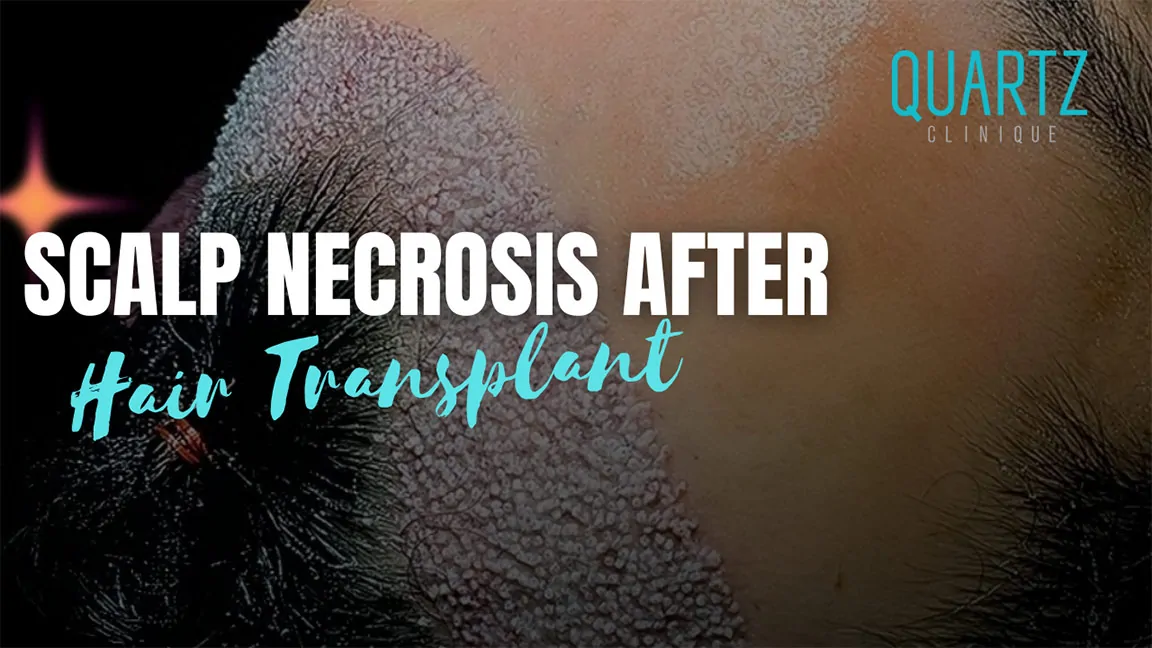Every surgical procedure carries certain risks, and hair transplantation is no exception. Although complications are rare, one of the most serious — yet fortunately uncommon — side effects is scalp necrosis after hair transplant.
Recognizing the early signs of scalp necrosis is crucial because timely medical intervention can minimize damage and improve recovery outcomes. In this article, we explain what scalp necrosis is, what causes it, how it can be prevented, and what treatments are available.
What Is Scalp Necrosis?
Necrosis refers to the premature death of tissue caused by inadequate blood supply or physical trauma. Unlike programmed cell death, necrosis happens accidentally and cannot be reversed.
In hair transplant surgery, scalp necrosis occurs when the skin tissue in a specific area loses its blood flow, resulting in cell death and permanent damage.
Necrotic tissue appears dark brown or black, feels leathery, and often becomes numb. Unfortunately, new hair cannot grow in areas affected by necrosis.
How to Identify Scalp Necrosis After Hair Transplant
After a hair transplant, it’s normal for small scabs to form as part of healing. However, necrosis looks very different.
Early diagnosis is vital — here are the main signs and symptoms:
- Persistent or severe scalp pain
- Discoloration of the skin (dark brown, gray, or black patches)
- Swelling, redness, or numbness around the affected area
- Delayed healing or a leathery appearance of the scalp
If you notice any of these symptoms, contact your surgeon immediately. The sooner treatment begins, the smaller the area of tissue loss.
What Causes Scalp Necrosis After Hair Transplant?
Scalp necrosis develops when blood supply to the scalp tissue is disrupted during or after the procedure. Several factors can contribute:
1. Over-Dense Graft Implantation
In an attempt to achieve maximum density, some surgeons may implant too many grafts into a small area.
This restricts oxygen flow to the tissue and damages local blood vessels, leading to reduced circulation and cell death.
A responsible surgeon carefully plans graft density to ensure each follicle receives enough oxygen and nutrients.
2. Deep or Repeated Incisions
Excessively deep or overlapping incisions can injure underlying vessels, causing poor blood flow and delayed healing.
This highlights the importance of choosing an experienced and certified surgeon familiar with advanced transplant techniques.
3. Smoking and Alcohol Use
Nicotine and alcohol constrict blood vessels, reducing oxygen delivery to scalp tissue.
Patients are advised to stop smoking and drinking at least 10 days before and after surgery to minimize vascular problems and promote faster healing.
4. Infection or Poor Hygiene
If post-operative care instructions are not followed and the scalp becomes infected, bacteria and inflammation can further damage the tissue and cause necrosis.
5. Scalp Trauma or Mega Sessions
Aggressive donor extraction (especially in large “mega sessions”) or repetitive trauma to the same area increases the risk of donor-site necrosis.
Patients with androgenetic alopecia may also have weaker vascularization, further elevating the risk.
Is Scalp Necrosis Common After Hair Transplant?
No — scalp necrosis is extremely rare, occurring in less than 1–5% of cases worldwide.
It is mostly seen after poorly performed surgeries or when post-op instructions are ignored.
Choosing an experienced surgeon with a strong medical background and advanced technology is the most effective way to prevent necrosis.
How to Treat Scalp Necrosis After Hair Transplant
If diagnosed early, necrosis management focuses on improving local blood flow and preventing infection.
Treatment may include:
- Topical nitroglycerine spray – increases blood circulation by dilating vessels.
- Antibiotic creams or oral medications – prevent bacterial infection.
- Steroid therapy – may be prescribed to control inflammation.
- Surgical debridement – in advanced cases, the necrotic tissue must be surgically removed.
- Once healing is complete, patients can consider scar revision or secondary transplantation (only after full recovery and medical approval).
Prevention: How to Avoid Scalp Necrosis After Hair Transplant
Both the surgeon and the patient play a role in preventing necrosis.
Here’s what you can do to minimize risk:
| Preventive Measure | Why It Matters |
|---|---|
| Choose an experienced surgeon | Reduces the chance of over-dense grafting or deep incisions |
| Quit smoking and alcohol | Improves blood flow and oxygen delivery to scalp tissue |
| Follow post-op hygiene rules | Prevents infection and promotes faster healing |
| Avoid overly large sessions | Minimizes trauma to donor and recipient areas |
Can Hair Grow Back After Scalp Necrosis?
Unfortunately, hair does not regrow in necrotic areas because the tissue and follicles are permanently damaged.
After recovery, scar revision or tissue grafting may be considered to improve the cosmetic appearance.
This is why prevention and early diagnosis are vital.
Scalp necrosis after hair transplant is a rare but serious complication that underscores the importance of surgical expertise and post-operative care.
By choosing a qualified, experienced surgeon and adhering to all aftercare instructions, patients can avoid this complication and enjoy long-lasting, natural results.
At Quartz Hair Clinic Istanbul, our board-certified surgeons perform advanced hair restoration using safe, minimally invasive techniques with a strong focus on patient safety and post-operative monitoring.

